12. GLORY

THE LAST DAYS OF THE GILDED AGE
AMERICA
CONTENTS
 America's immense industrial capacity America's immense industrial capacity
ranks it as a rising world power
 America makes key contributions to America makes key contributions to
modern technology
 Rapid industrialization and heavy Rapid industrialization and heavy
immigration create their own dynamics
 Leading it all was an American social Leading it all was an American social
elite as fancy as any European elite
 Meanwhile ... American women are Meanwhile ... American women are
finding their own political voice
 Also ... America's intellectual-spiritual Also ... America's intellectual-spiritual
challenges at the turn of the century
 But in general, life in "Middle America" But in general, life in "Middle America"
is quite good
 The gilded calm before the storm The gilded calm before the storm
The textual material on page below is drawn directly from my work
A Moral History of Western Society © 2024, Volume Two, pages 61-66.
AMERICA'S IMMENSE INDUSTRIAL CAPACITY RANKS ITS AS A RISING WORLD POWER |
The Industrial Revolution.
Across the Atlantic, America was very busy developing along economic
lines very similar to Europe's. As already noted, America, in
fact, was way ahead of Europe in this game of industrial
development. But unlike Europe, this development had virtually
nothing to do with governmental policy. It was all done under the
control of very wealthy "private" entrepreneurs ... who felt themselves
to be in no need whatsoever of government assistance in the development
of their particular business interests. Personally-cultivated
capitalism worked just fine for them.
But for the industrial workers, driven from the American farms by
overpopulation and drawn from those escaping the "Old World" of Europe
in the hope of finding in America a better opportunity for their own
development, things were proving to be quite hard. A labor
movement of sorts had developed in the 1880s ... but had not done well,
and simply died.
|

The Bessemer process of steel
making
Library of Congress

New York workers laying street
car tracks - 1891
The Museum of the City of
New York

Construction of the New York
City subway - begun in 1902 with first station opened in 1904
New
York Public Library
AND AMERICA MAKES KEY CONTRIBUTIONS TO MODERN TECHNOLOGY |
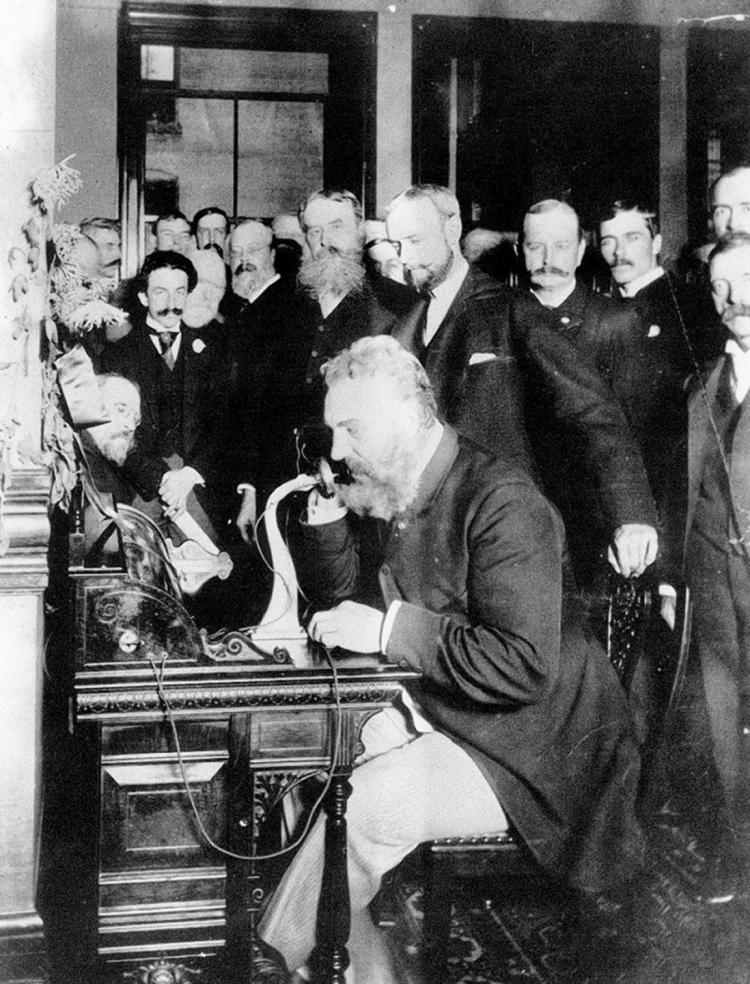
Alexander Graham Bell (actually Scottish) demonstrating
the telephone in Boston - 1876

Edison gets a very early start in his life of invention in 1878 with the creation of the phonograph
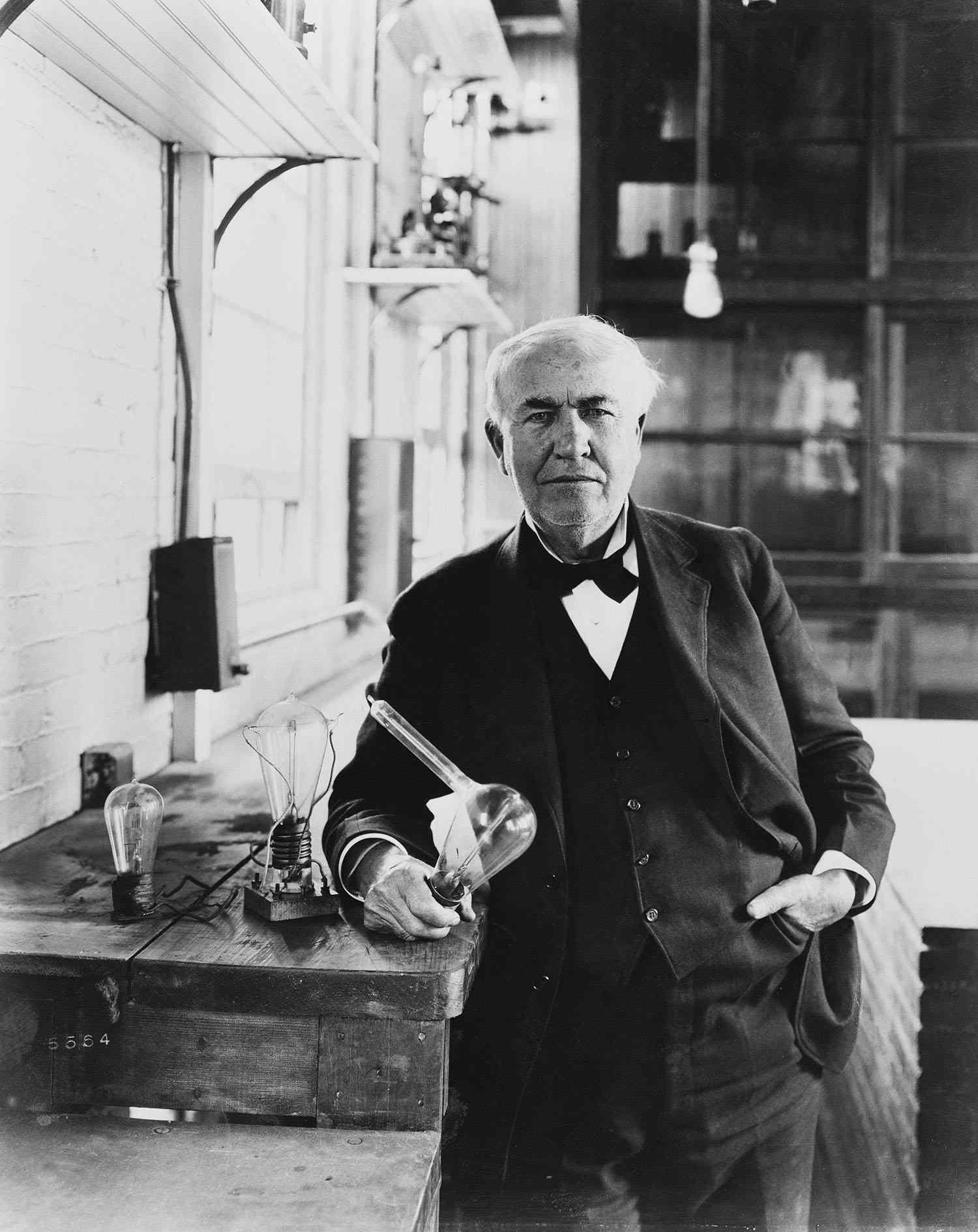
Edison discovered and developed the light bulb - 1879-1880

Edison and his kinetoscope (an early personal motion-picture device) - 1889
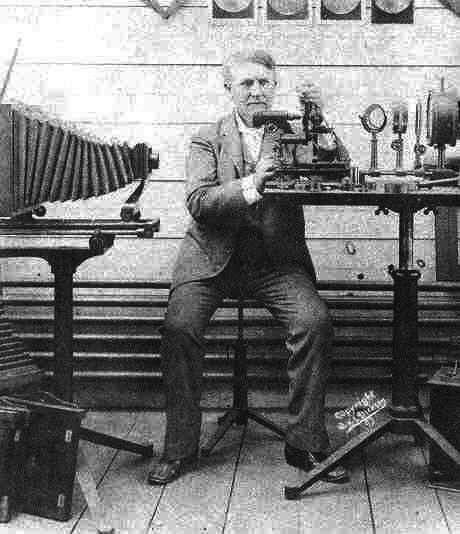 Edison and an experimental
microscope camera.
Edison and an experimental
microscope camera.
U.S. Department of the Interior,
National Park Service, Edison National Historic Site, West Orange, NJ
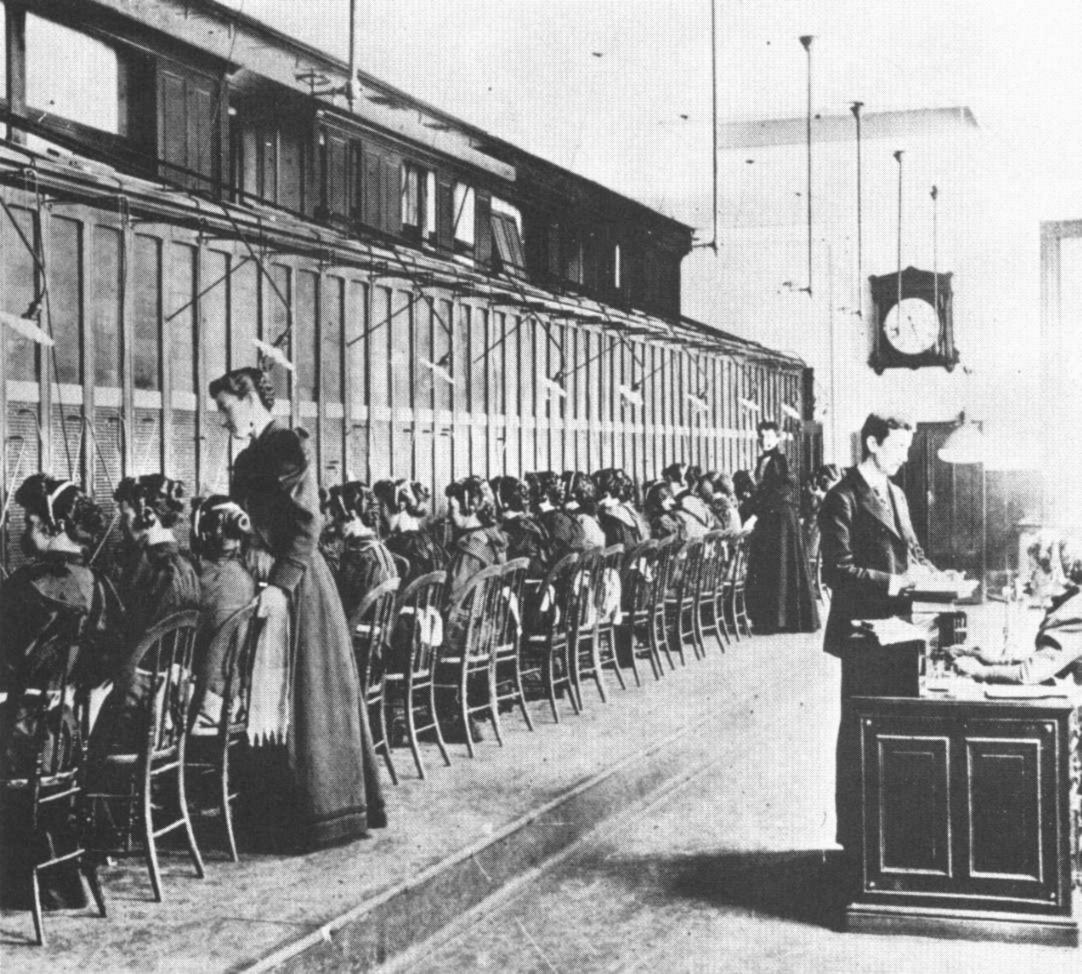
The telephone exchange in New York City - 1888
And new machinery to increase greatly America's food production capacity

A John Deere header machine
for reaping wheat
Kansas State Historical
Society
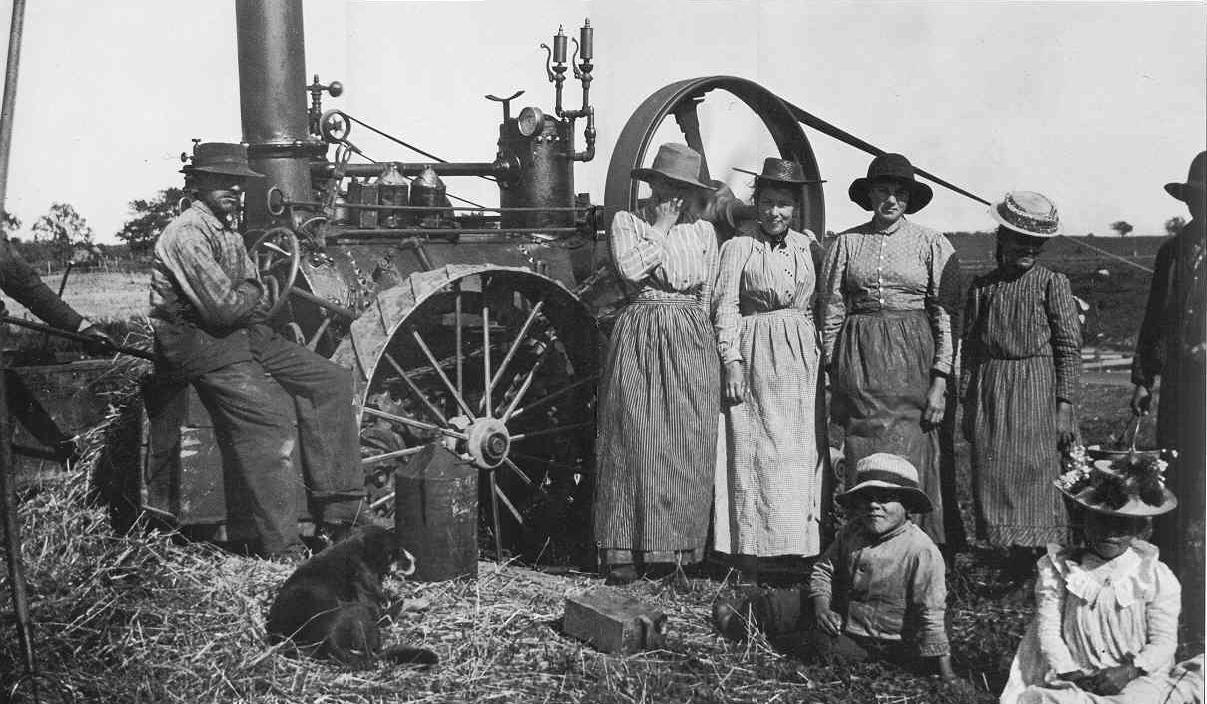
"High-tech" on a Minnesota
farm - 1901
Minnesota Historical
Society
And the development of the all-important automobile

A prosperous country family
in a Haynes Touring Car

The finish of a transcontinental
auto tour - 1904

Drivers preparing for the
start of the 1909 Indianapolis 100-mile race (the event was won by Louis Strang with
an average speed of 64 miles per hour)
 Henry Ford and
a Model T Ford
Henry Ford and
a Model T Ford
(in 1908 he began production of the Model T, which by 1927 he had sold 15 million)
Henry Ford Museum

Ford assembly line -
1914
Ford Motor Company, Stevens
Institute of Technology
 Ford assemby line - 1913
Ford assemby line - 1913
Ford Motor Company
 "1913 - Trying out the new
assembly line"
"1913 - Trying out the new
assembly line"
By an unknown photographer,
Detroit, Michigan
National Archives
 One day's production from
this Ford assembly plant: 1000 Model T bodies
One day's production from
this Ford assembly plant: 1000 Model T bodies
Henry Ford Museum & Greenfield
Village

Model T Fords at the end
of the assembly line
Library of Congress
... and simultaneously the development of the airplane
 First flight at Kitty Hawk,
North Carolina, December 17, 1903. Orville Wright at controls.
Wilbur Wright at right (First flight was 12 seconds)"
First flight at Kitty Hawk,
North Carolina, December 17, 1903. Orville Wright at controls.
Wilbur Wright at right (First flight was 12 seconds)"
By Orville Wright and John
T. Daniels, December 17, 1903

The Wright brothers demonstrating
their flying machine at the Tempelhof airstrip, Berlin - July 1909
RAPID INDUSTRIALIZATION AND HEAVY IMMIGRATION CREATE THEIR OWN DYNAMICS |

Child labor at a South Carolina plant making thread for cloth-weaving - 1908
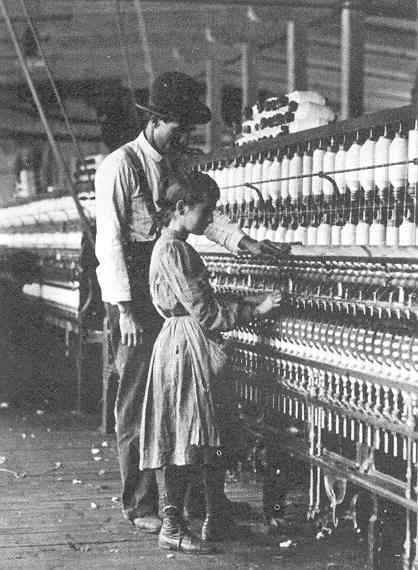



Child Laborers in Indiana
Glass Works, Midnight, Indiana - 1908
Photographer: Lewis W. Hine
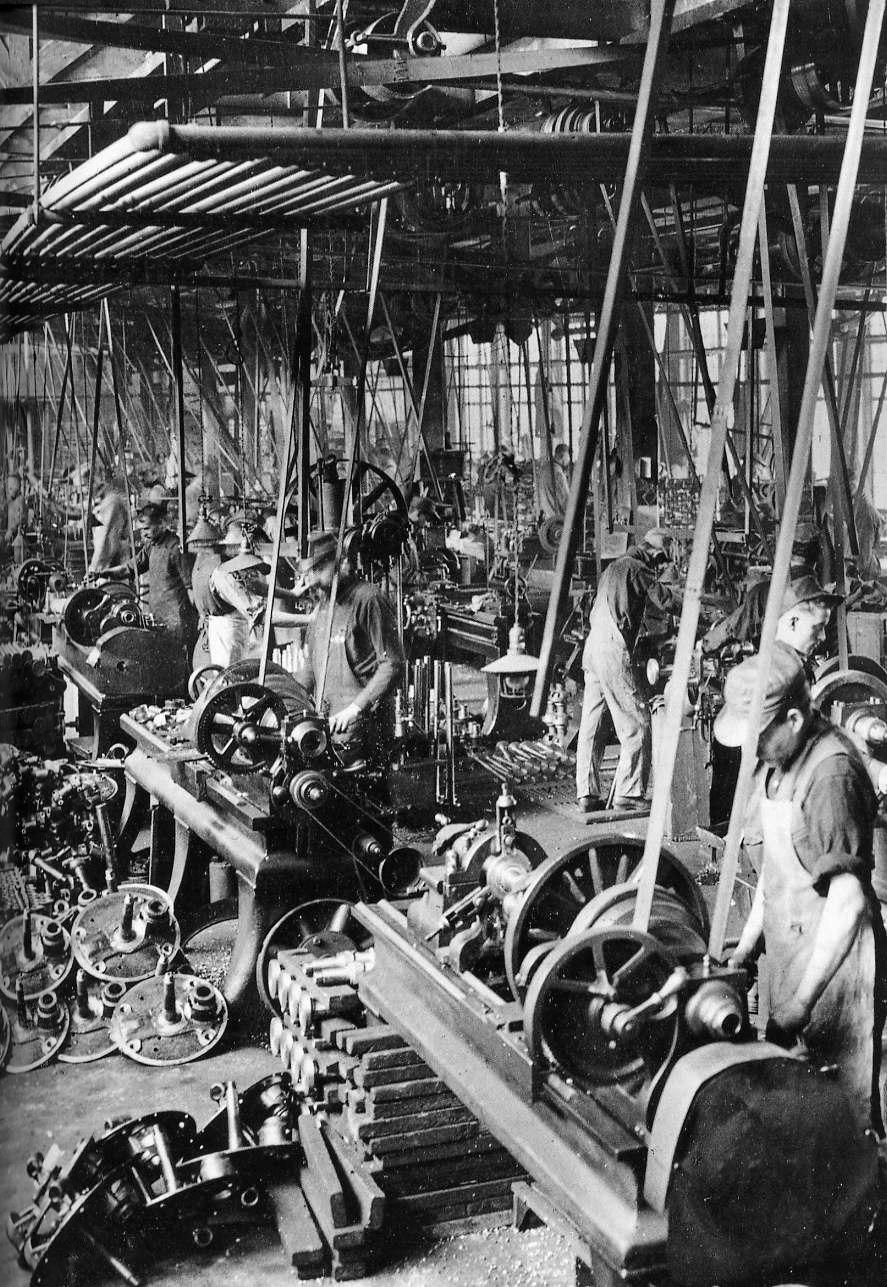
The working world at the Nash Motor Company

Ladies Taylors Strikers - 1910

Deputies awaiting strikers at the Williamsburg Sugar Plant - 1910

State troopers holding strikers in check in Lawrence, Massachussetts - 1912

Strikers manacing strike-breakers at the Lawrence, Mass plant - 1912

Italian immigrants arriving at Ellis Island

Immigrants arriving at Ellis Island

Italian immigrants working at home
Life in New York's ethnic districts


Lower East Side (New York City) tenements .. beds for five cents a night
LEADING IT ALL WAS AN AMERICAN SOCIAL ELITE ... AS FANCY AS ANY EUROPEAN ELITE |
Industrial greed benefits an ever-smaller percentage of American society.
Tragically, the spread in the level of wealth between the great
capitalists (the Vanderbilts, Andrew Carnegie, J.P. Morgan, the
Rockefellers, etc.) and the industrial working-class families became
outrageously high for a supposedly "democratic" America.
Basically, the top one percent of the population earned fifty percent
of the nation's wealth. The bottom half or lower fifty percent of
the population together earned or possessed about one percent of the
nation's wealth. This was morally unacceptable in a society
posing itself as the model of "democracy."
Finally, the danger this posed to the "American way" was answered by
the very ambitious and very active President Teddy Roosevelt
(1901-1909), who undertook to push anti-trust legislation forward ...
and aim it at a number of American industrial monopolies. And his
replacement in the presidential office, Howard Taft (1909-1913), would
push antitrust actions to an even greater extent.
Capitalism in America was a wonderful system. But it would have
to function under various rules or restrictions designed to not let the
pure greed of a few individuals or organizations take over the American
economy.
So absorbed was America in its own fabulous industrial development that
it treated international matters, especially the urge to imperialism,
only as a rather secondary matter. However, developments in
Hawaii, rebellion in China, revolt in Cuba, and dwindling Spanish power
in the Philippines did stir enough interest in American political
circles to get America involved ... though its involvement seemed
rather minor in comparison to the actions abroad by the British and the
French ... and the efforts of Germany to put itself in the same league
with the British and the French.
Thus despite its massive industrial capacity, America was thought of by
its fellow Westerners as being a national power of only a secondary
order. There was, in fact, little interest in drawing America
into the imperial game as a valuable ally. So ... the imperialist
game seemed to move forward without great American involvement in the
matter. But that would soon change.
|

John D Rockefeller and son

J.P. Morgan and son and daughter


Gentlemen enjoying a dinner on horseback!

Ladies promenading in fashionable Newport, Rhode Island

The Vanderbilt home in New York City
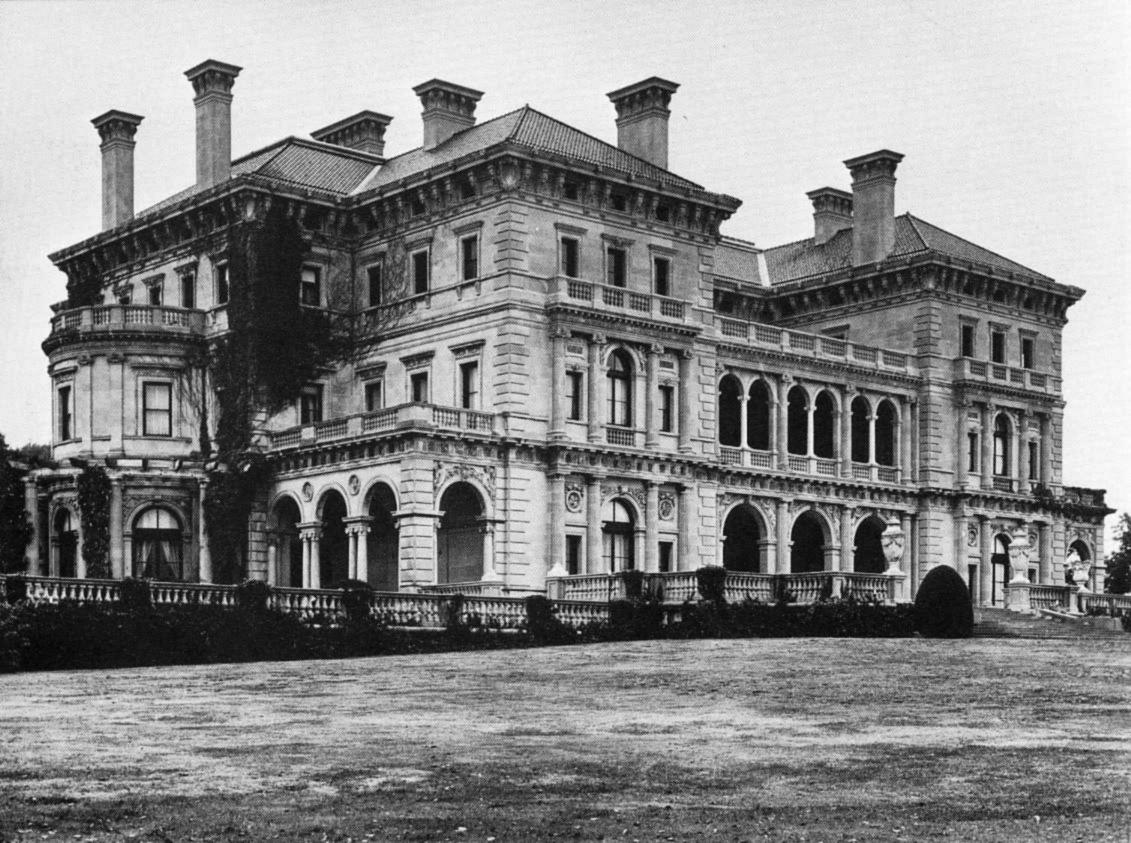
The Vanderbilt home (the "Breakers") in Newport, Rhode Island

The dining room at the Breakers
MEANWHILE ... AMERICAN WOMEN ARE FINDING THEIR OWN POLITICAL VOICE |
... not just to combat disastrous male alcohoism (the Women's Christian Temperance Union) ... and the need for social progress (health, education, family safety)
but simply because "equality" must allow them to play the same role in life as the men

Women marching in Washington, D.C., for voting rights - 1914
ALSO ... AMERICA'S INTELLECTUAL-SPIRITUAL CHALLENGES AT THE TURN OF THE CENTURY |
With
the distancing in time from the Civil War, once again America fell back
into a world of humanistic rationalism, pretty much along the same
lines as what was developing in Europe. Again, the Christian faith in
America found itself deeply challenged by this intellectual-spiritual
shift.
 America
"Liberalism" was growing rapidly in the world of academics, government,
and even religion. And it took on qualities not all that different
from the political idealism of Karl Marx. Liberals, such as the
prolific writer and lecturer John Dewey,
blamed flaws in the social structure, not flaws in the human heart, as
the cause of the social problems still facing the country. According
to Dewey, if you reform the social structure then the problems will go
away. True, some "education" of the masses will have to take place in
order to release them from the grip of antiquated thinking. Like
Lenin, Dewey believed that this was the special responsibility of those
already enlightened to society's truths. But (also like Lenin) he
believed that this would be merely a temporary stage in social-cultural
development that a society would have to go through, before the masses
were ready to take on freely a fully enlightened world. Thus American
Liberalism came to be understood as a program of deep social reform –
reform led (just temporarily, of course) by the more enlightened of
society. America
"Liberalism" was growing rapidly in the world of academics, government,
and even religion. And it took on qualities not all that different
from the political idealism of Karl Marx. Liberals, such as the
prolific writer and lecturer John Dewey,
blamed flaws in the social structure, not flaws in the human heart, as
the cause of the social problems still facing the country. According
to Dewey, if you reform the social structure then the problems will go
away. True, some "education" of the masses will have to take place in
order to release them from the grip of antiquated thinking. Like
Lenin, Dewey believed that this was the special responsibility of those
already enlightened to society's truths. But (also like Lenin) he
believed that this would be merely a temporary stage in social-cultural
development that a society would have to go through, before the masses
were ready to take on freely a fully enlightened world. Thus American
Liberalism came to be understood as a program of deep social reform –
reform led (just temporarily, of course) by the more enlightened of
society.
 On the governmental side of this same Liberalism was the Supreme Court Justice Oliver Wendel Holmes,
who took a very "progressivist" view of the American Constitution,
understanding that it needed to be constantly adjusted to fit the
changing context of society's ever-changing dynamics. In short, the
Constitution needed to be understood to be whatever the currently
serving justices saw the need for it to be ... sort of a "Legal
Realism" being their guide. Thus the real Constitution was not to be
found in an ancient document, but in the hearts and minds of very wise
Supreme Court justices! On the governmental side of this same Liberalism was the Supreme Court Justice Oliver Wendel Holmes,
who took a very "progressivist" view of the American Constitution,
understanding that it needed to be constantly adjusted to fit the
changing context of society's ever-changing dynamics. In short, the
Constitution needed to be understood to be whatever the currently
serving justices saw the need for it to be ... sort of a "Legal
Realism" being their guide. Thus the real Constitution was not to be
found in an ancient document, but in the hearts and minds of very wise
Supreme Court justices!
Thus to a rising group of American Liberals, "democracy" was to be a
social program "coming from above," not from the desires and actions of
the unreformed masses.
This same kind of "Enlightened Realism" also found its way into the
Christian world of America, not surprisingly among some of its leading
voices of the day. Reason seemed once again to dictate the need to do
some updating of the faith, getting it away from the ancient myths
found in Scripture – in order to help the faith deal with the issues
more at hand at the time. Thus Biblical "text-criticism" became the
fashion in seminaries training a rising generation of pastors to be
more "realistic" in their approach to Scripture, and thus their
Christian walk (and preaching).
This was hardly a new development, something that had already shaken
the Christian West back in the late 1600s and early 1700s. And of
course it demonstrated amply the horrors of such "enlightenment" in the
French Revolution, dedicated to exactly that same post-Christian
enlightenment – which unsurprisingly the Enlightened Ones ended up
slaughtering each other because they could not agree on the directions
such enlightenment was supposed to take them.
But American Christianity had thankfully not really gone down that road
very far, and subsequently – the mid-1700s to the mid-1800s – had been
able to return to its more traditional understanding of life and its
dynamics, in order to put America back on track as being a "Covenant
Nation" … and take on successfully the nation's accompanying challenges.
But here at the end of the 1800s, a fully settled America found itself
once again back in the mood to repeat the ways of the earlier "Age of
Enlightenment." The milder form this would take would be found in the
development of the "Social Gospel" – an effort of Congregationalist
pastor Washington Gladden, the Baptist pastor and seminary professor,
Walter Rauschenbusch and the economist Richard Ely to find some kind of
"middle ground" between Christian traditionalism and modern Secular
science. They skirted theological controversy by simply emphasizing
that Christianity was about social service, to the poor and hurting.
Of course there was nothing particularly Christian about this, in the
sense that any person of humane sentiments (Confucianist, Buddhist,
Hindu, Muslim) would find themselves agreeing that this was a very
important way to go at life. But ultimately it had nothing to do with
Christ's eternal salvation. Indeed, the Social Gospel treated such a
traditional concern as very problematic.

Washington Gladden

Walter Rauschenbusch

Richard Ely
 Then
there was what appeared to most of the faithful as a very strong attack
on Scripture as the foundation of all key Truths in life. The huge and
very traditionalist Presbyterian denomination found itself deeply
troubled by the "text-criticism" offered by Union Theological
Seminary's professor Charles Briggs, who was perceived as treating
Scripture as folklore rather than absolute truth. Briggs pointed out
that Moses did not write the books attributed to him, but instead those
writings were most likely put together many centuries after him – by
drawing from four different traditions. And he also stated that the
second half of the Book of Isaiah most likely had been put together
after Isaiah's death by his disciples. Then
there was what appeared to most of the faithful as a very strong attack
on Scripture as the foundation of all key Truths in life. The huge and
very traditionalist Presbyterian denomination found itself deeply
troubled by the "text-criticism" offered by Union Theological
Seminary's professor Charles Briggs, who was perceived as treating
Scripture as folklore rather than absolute truth. Briggs pointed out
that Moses did not write the books attributed to him, but instead those
writings were most likely put together many centuries after him – by
drawing from four different traditions. And he also stated that the
second half of the Book of Isaiah most likely had been put together
after Isaiah's death by his disciples.
At a time when truth was coming to have a strongly material basis in
the thinking of most Westerners, such attacks on the material or
"factual" foundations of scripture appeared to most Christian Americans
as being absolutely heretical. Thus the denomination in 1893 voted to
excommunicate Briggs, and attempted to remove him from Union Seminary.
Union Seminary, however, chose instead to remove itself from the
Presbyterian denomination. And Briggs continued his studies and
teaching there.
 On the other hand, the very popular circuit preacher/evangelist Dwight L. Moody
was able to take the rising social doctrines of Progressivism and
combine them with the idea of cleaning up America's sins in
anticipation of Christ's second coming, all without involving any
commentary on the burning theological disputes of the day. This made a
lot of sense to independent-minded "Middle Americans" who simply wanted
to find in their Christian faith the guidance they needed personally to
get through the changing times of the late 1800s, and prepare for the
eternal life to come. Thus thousands came out to hear Moody's
preaching. On the other hand, the very popular circuit preacher/evangelist Dwight L. Moody
was able to take the rising social doctrines of Progressivism and
combine them with the idea of cleaning up America's sins in
anticipation of Christ's second coming, all without involving any
commentary on the burning theological disputes of the day. This made a
lot of sense to independent-minded "Middle Americans" who simply wanted
to find in their Christian faith the guidance they needed personally to
get through the changing times of the late 1800s, and prepare for the
eternal life to come. Thus thousands came out to hear Moody's
preaching.
Also, there was a most unusual (unusual in terms of more traditional
Christianity) pentecostal or charismatic "awakening" which broke out
with the Azusa Street Pentecostal revival in Los Angeles in 1906. And
this in turn birthed the charismatic Assemblies of God denomination,
which would grow – and is still growing to amazing size – not only in
America but also internationally. Thus it was still understood by many
Americans that its nation still had God's work to pursue.
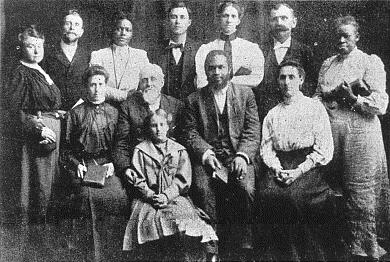
Leaders of the Azusa Street revival
But most tragically, few of the Secular "Enlightened Ones" on the other
side of the spiritual fence at this point had any sense of the collapse
of all reasonable social order awaiting them only a few years into the
future (the coming "Great War" of 1914-1918). They too were positive
that they were moving into an "End Times," although not one delivered
by God, but instead one delivered by the Human Reason by which they
intended to guide the rest of society. But sadly, this march forward
of history would hit the country tragically when the Liberally
enlightened American President Woodrow Wilson would take America into
the ghastly European War in 1917, to make the world "safe for
democracy."
So it was that democracy ("democracy" as conceived by political
experts) rather than God's covenantal program would come to take over
as America's main program. The results would be very bloody, and
ultimately very pointless.
|
BUT IN GENERAL, LIFE IN "MIDDLE AMERICA"
IS QUITE GOOD |
Life in Rural America

The Dorrance telephone
switch-board
Kansas State Historical
Society
 The Dorrance Lutheran Church
(one of 4 churches in town)
The Dorrance Lutheran Church
(one of 4 churches in town)
Kansas State Historical
Society

A grain elevator built by
German immigrants - who brought with them the winter wheat grown locally
Kansas State Historical
Society
Life in the urban "Middle America" (Grand Junction, Colorado)
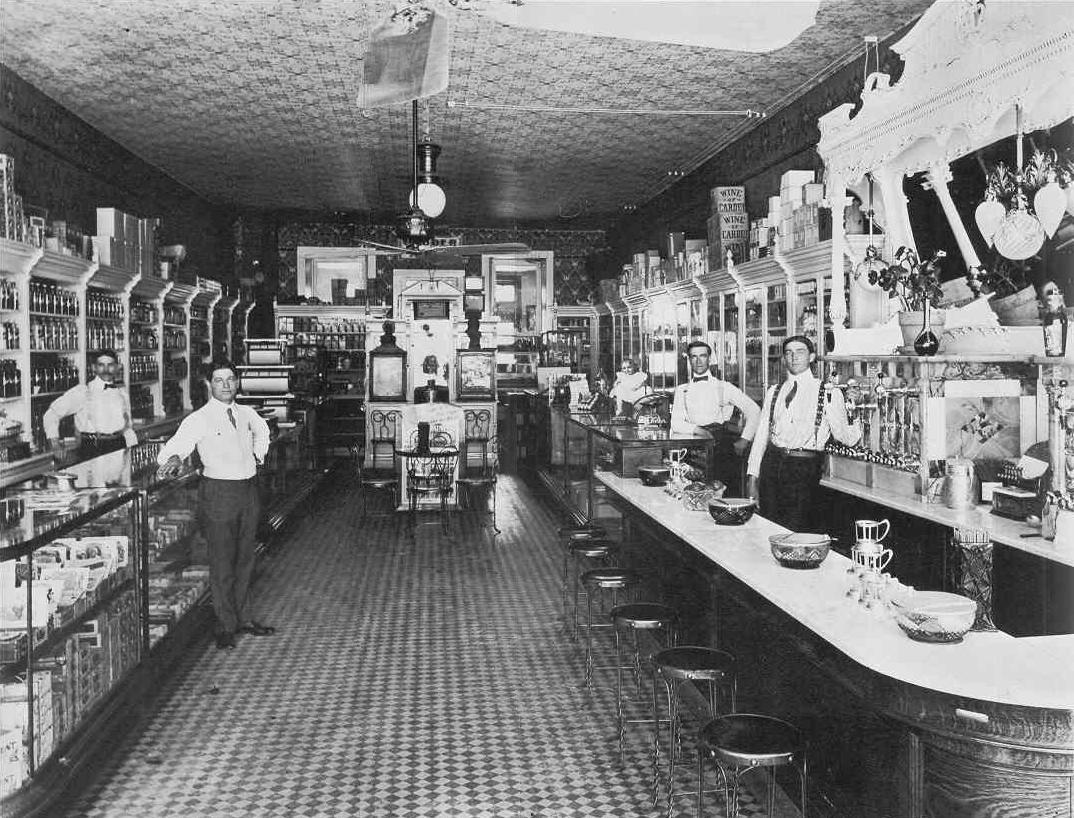
Loeb and Hollis Drug Store
in Grand Junction
Pennell Collection, University
of Kansas

Latham's Grocery in Grand
Junction
Pennell Collection, University
of Kansas

The Pegues, Wright Department
Store in Grand Junction
Pennell Collection, University
of Kansas

Rudy Sohn's barber shop in
Junction City, Kansas
Pennell Collection, University
of Kansas

Ladies' sewing circle - Black
River Falls, Wisconsin
Historical Society of
Wisconsin

Keeping up with the latest
fashions in rural Industry, Illinois - 1911
(my grandmother is second from the left)
 An American classroom - around
1900
An American classroom - around
1900

Fire department No. One,
Woodbine, New Jersey

An American family dining room - 1906

Kids waiting for ice delivery (and extra pieces!) - Cleveland - 1910
And Middle America had its own "style" as to how it relaxed and enjoyed life

Rosebowl Football Game - 1902

Americans vacationing at Daytona Beach, Florida - 1904

Baseball - Boston versus New York - 1904

Traveling shows - an Indian "exhibit" -1904

The Saint Louis World Fair - 1904

Harvard versus Yale football - 1907
And life in "big-city" America could be quite elegant
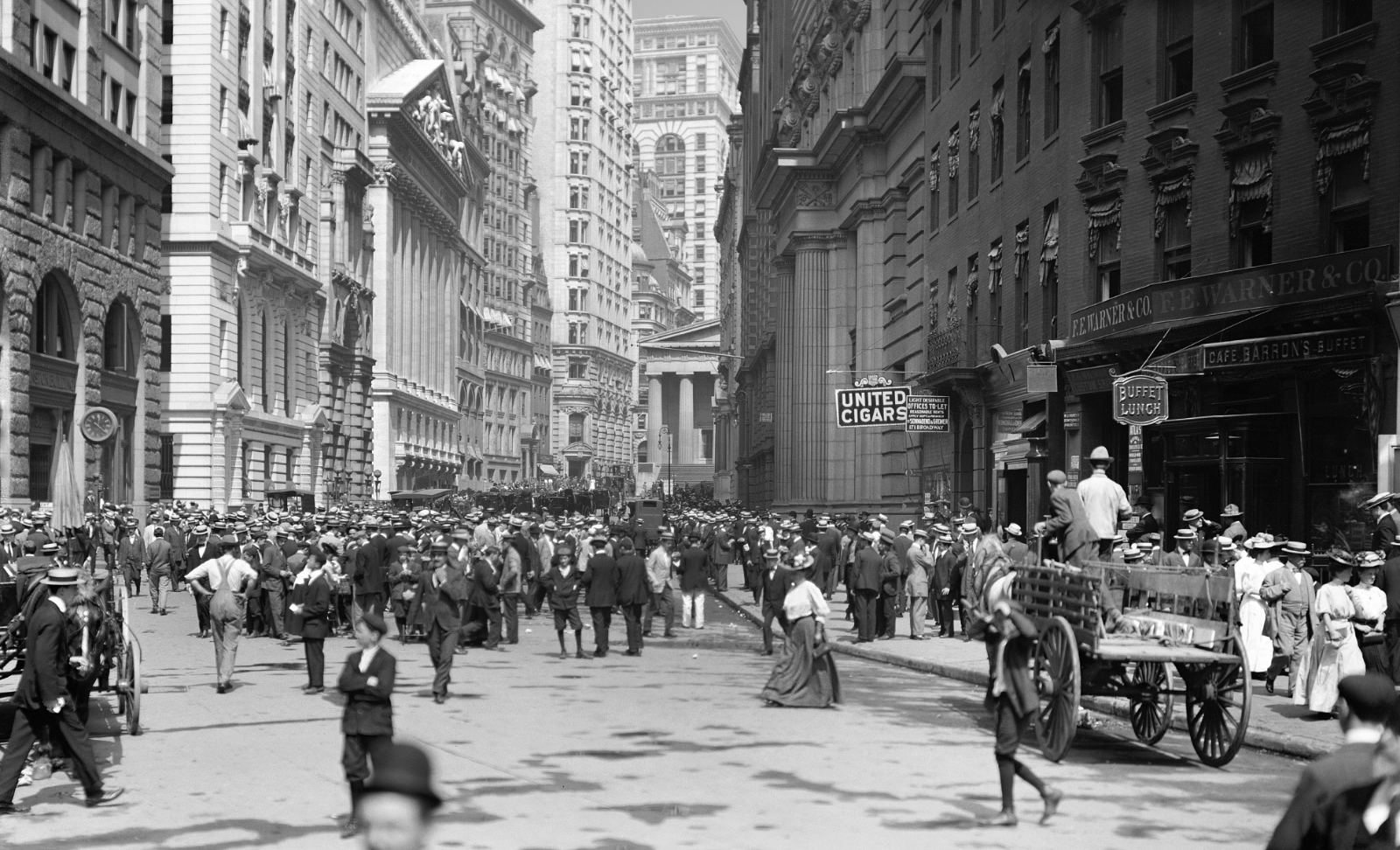
Wall Street - New York City
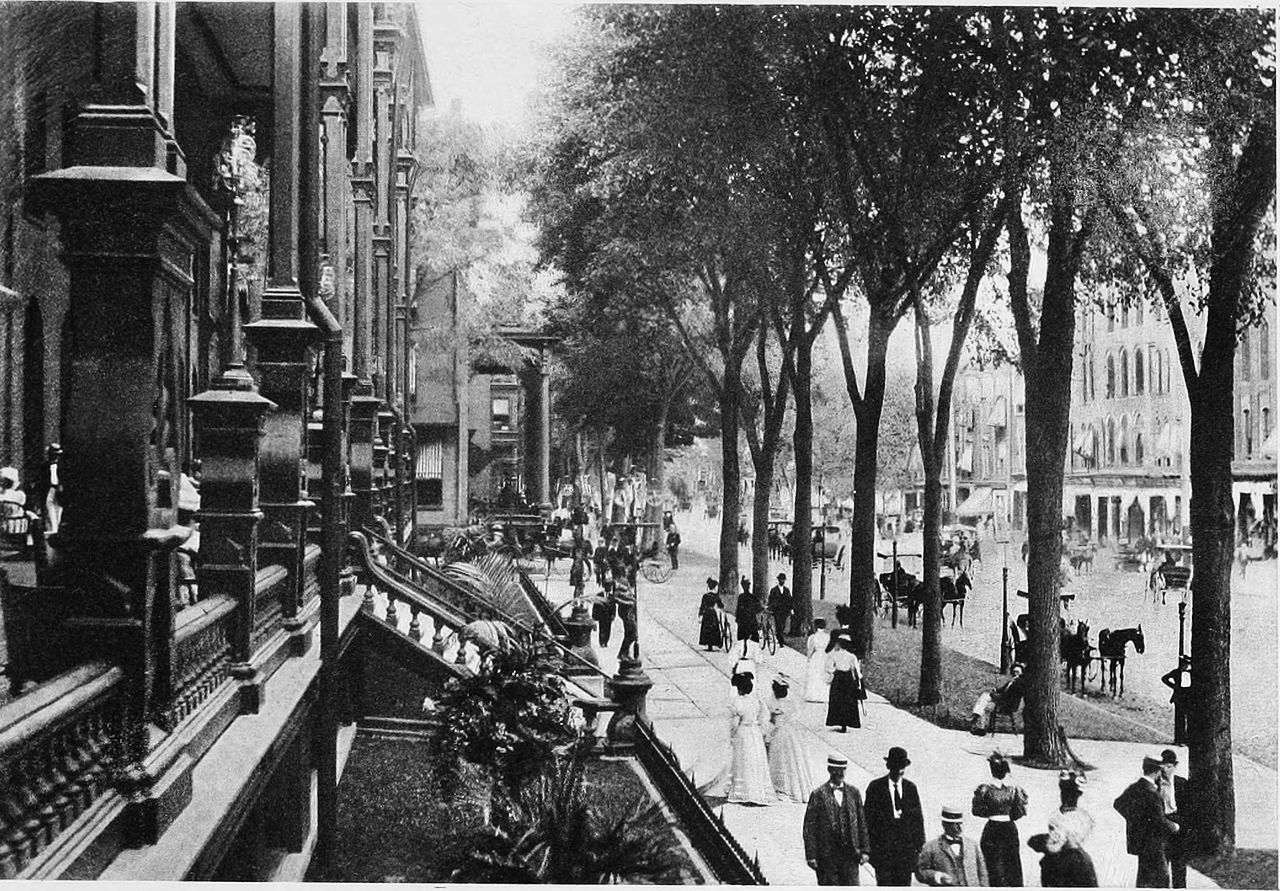

THE GILDED CALM BEFORE THE STORM |
So
... at the turn into the twentieth century most of Western society
seemed to be clearly at the top of its game. Many already called
this the "Gilded Age" ... where everything seemed to be
gold-lined. True, the world was still engaged in rapid social
change, and perfection had not yet been fully achieved. But all
this change seemed to be in a direction entirely positive in character
... and seemed to promise that utopia was at hand. The common
people were enjoying unprecedented new powers as designers of their own
destiny. Even kings and emperors seemed to have been brought
under the power of the people.
Wealth was clearly expanding, though reaching the lower classes only
with difficulty. But even in this matter, just as the middle
class had recently secured vital political and economic rights wrested
from the old feudal order, socialist reformers were certain (Marx had
clearly demonstrated to them how this all was an inevitable historical
development) that soon the working classes would be wrestling those
same political and economic rights from the middle class industrialists
(or "capitalists"). Such utopian progress was certain ... and
just around the corner.
But storm clouds were gathering that would change this game plan
dramatically ... in a way few observers anticipated in those first
years of the twentieth century. Europe was about to go through
such a nightmare of events that even in finally getting through it all,
Europe would never be the same.
The Gilded Age was about to come to a dramatic close.
|

Go on to the next section: World War One
 Miles
H. Hodges Miles
H. Hodges
|


 America's immense industrial capacity
America's immense industrial capacity America makes key contributions to
America makes key contributions to Rapid industrialization and heavy
Rapid industrialization and heavy Leading it all was an American social
Leading it all was an American social Meanwhile ... American women are
Meanwhile ... American women are Also ... America's intellectual-spiritual
Also ... America's intellectual-spiritual But in general, life in "Middle America"
But in general, life in "Middle America"  The gilded calm before the storm
The gilded calm before the storm













































































